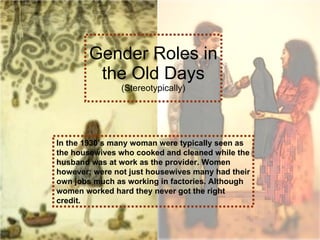
Gender Roles 1930s
- 1. Gender Roles in the Old Days (Stereotypically) In the 1930’s many woman were typically seen as the housewives who cooked and cleaned while the husband was at work as the provider. Women however; were not just housewives many had their own jobs much as working in factories. Although women worked hard they never got the right credit.
- 2. Women
- 3. The typical American woman is shown in the world as a housewife. Many advertisements and pictures show the housewives as women happy to stay home, clean and care for the children.
- 4. Women who are housewives are frequently stressed and overwhelmed. They are typically seen as women who are very well dressed to do house hold chores. They were also shown dressed up to look their best for their husband.
- 5. Many women were employed in the 1930’s. A woman had to get a full education to be equal to a male who only graduated from elementary school.
- 6. Women in the 1930’s were utilized as factory workers and many other low paid jobs. Women worked hard and long at factories such as this one to get a low cut of money in comparison to the wages of a male worker.
- 7. Men
- 8. The man is seen as the intellectual individual who takes care of their wife. The man who arrives home with the money.
- 9. The American male has stereotypically been shown as the supplier. Many typical men were seen as railroad workers.
- 10. Here you see a man at age of around forty-six doing “the man work”. Men were always to do the heavy work required.
- 11. Here you notice this is a man who is ready for military service. Military was always a male occupation. It was unheard of for a women to be in the military.
- 12. Many women are not the typical housewives they are the producers. This advertisement quotes “Sometimes the best man for the job isn’t a man!” The advertisement was much later than the 1930’s and was used towards women to grasp their interest into becoming an army soldier.
- 13. Women and men worked together in the army fighting side by side to stand up for America. Women usually were disguised as men to fight for their country since they were not permitted. It was not tolerable for a women to be in the army for the reason that it simply was not their job.
- 14. N.O.W., National Organization of Women was an organization which was developed many years after the 1930’s. The group took effect on how women in America were treated. N.O.W. stood for several years but later failed.